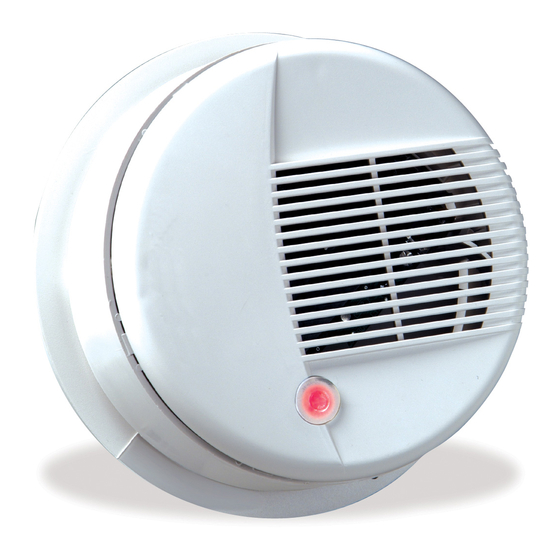DSC AMS-220T Installatie- en bedieningsinstructies - Pagina 3
Blader online of download pdf Installatie- en bedieningsinstructies voor {categorie_naam} DSC AMS-220T. DSC AMS-220T 4 pagina's. Addressable smoke detector dsc ams-220/220t

Mounting the Unit
The AMS-220 Smoke Detector mounts to a standard 4" octagonal
electrical box.
Remove the mounting plate from the case by pushing the locking tab
and turning the mounting plate counter-clockwise. Attach the mounting
plate to the electrical box (see diagram below for orientation).
Wiring
Refer to the connection diagram below:
Before connecting the unit, prepare the wires from the electrical box
for connection; the wires should not be frayed or bent.
CAUTION: If the power connections are reversed, the unit will
not operate. The unit is protected against damage from incorrect
wiring.
When wiring is completed, inspect the wiring and correct any errors
before applying power to the unit. When the wiring has been
thoroughly reviewed, neatly insert the wires into the electrical box
and secure the unit to the mounting plate.
THIS EQUIPMENT SHOULD BE INSTALLED IN ACCORDANCE
WITH THE NATIONAL FIRE PROTECTION ASSOCIATION'S
STANDARD 72 (National Fire Protection Association, Batterymarch
Park, Quincy, MA 02269).
Device Enrollment
The serial number located on the back of the device must be
enrolled into the alarm control panel via Installer's Programming
([ ] [8] [Installer's Code]). This procedure is outlined for the
PC4010/4020 v3.0 in the control panel Installation Manual.
WARNING: Connect only DSC Addressable Series devices to
the addressable loop connections. Connection of ANY other
type of device will impair operation. Any devices other than
Addressable Series devices which require power to operate
must be powered separately.
Dust Cover
The dust cover is intended to protect the unit from dust and dirt
entry, only while the unit is not in service.
CAUTION: The smoke detector will not function with the dust
cover in place.
Installation Testing
When all connections are completed, apply power to the system as
described in the control panel's installation manual. If all connections
are correct, there should be no alarm from any of the smoke
detectors. If an alarm occurs, ensure that there is not an actual alarm
condition. If there is no actual alarm, remove power from the system
and check all smoke detectors for correct wiring.
If no alarm occurs, test each smoke detector by turning the Smoke
Test option ON in the control panel's installer's programming mode.
The programming sections are as follows:
PC4010/4020 (v3.0) Reference Number [0014XX02]
where XX=Partition #
If a detector fails any part of the test, the zone will be latched in the
trouble state until the next test or until you exit the Installer's
Programming mode. The test will take 60 seconds.
Testing Smoke Detector Sensitivity
The sensitivity of the smoke detector should be verified at least once
per year.
Smoke sensitivity may be measured in a correlated UL268 or
CAN/ULC S529-M87 smoke box. DSC will conduct this test for a
nominal charge. If a returned unit is found outside of its marked
sensitivity range, DSC will clean and restore the unit's sensitivity
to its marked range.
Smoke sensitivity of installed detectors can be measured without
removal with the Gemini Model 501 Aerosol Smoke Detector
Analyzer*. Follow the instructions supplied with the instrument. Start
with the sensitivity corresponding to the lowest marked detector
sensitivity; no alarm should be indicated. Reset with the highest
sensitivity setting; an alarm should then be indicated. (Enter an
access code at a system keypad to silence the alarm. Consult the
system instruction manual for information on fire alarm operation
and testing. Before testing, alert the occupants and the monitoring
station that a fire alarm test is being conducted.) These results
indicate that the unit is within its marked sensitivity range. Other
settings can be tried to bracket the detector's sensitivity to a
narrower sensitivity range, such as may be important during annual
tests to quantify any change over time.
Installer's Maintenance Instructions
Normally, the AMS-220 Smoke Detector will not require maintenance.
If the unit is mounted in a high dust environment, the inlet areas of
the case may be vacuumed with a soft brush attachment.
Be sure to inform the user and their monitoring station when
maintenance of any sort is performed on the smoke detector or any
part of the alarm control system. Always test smoke detectors after
maintenance. If a smoke detector continues to generate nuisance
alarms even after vacuuming, return the unit to DSC for service.
Contact DSC at the address and number below to obtain a return
authorisation number before returning the unit.
Installer's Responsibility to the User
It is the Installer's responsibility to thoroughly instruct the end user
of the system on the operation, testing and maintenance of their
system. The Installer should fully explain and demonstrate all
functions of the alarm control system and any equipment, such as
smoke detectors, connected to it. The user should be provided with
all instruction sheets and manuals for their system and any
components connected to it. Complete and thorough instruction for
the user is essential to ensure they will obtain the greatest benefit
from their system. Providing the user with complete operational
information will also benefit the Installer through a reduction in
service calls for nuisance alarms.
